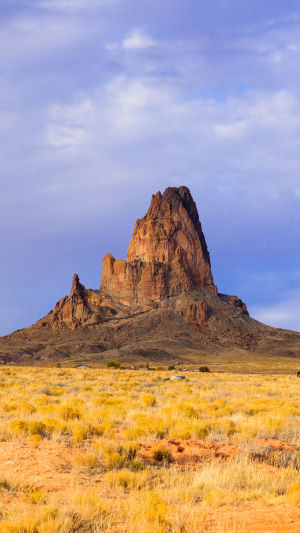We had no grand plans to stop, but as soon as we saw Agathla Peak rising from the flat desert, we knew we had to. There's something about its rugged, solitary presence that feels almost otherworldly. It's a reminder of how ancient and powerful the earth can be, and it instantly brings a sense of calm and awe.
Little did we know, this place holds deep cultural significance to the Navajo people, and we were about to experience more than just a photo stop.
<h3>First Impressions of Agathla Peak</h3>
As we stood there with our camera in hand, the desert stretched endlessly around us. The late afternoon light painted the scene in golden hues, casting long shadows over the land. Agathla Peak stood tall, a volcanic plug left behind after millions of years of erosion, the remnants of a once-active volcano. It felt like a natural monument, untouched by time.
At first glance, it might seem like just another beautiful rock formation in the Southwest, but the Navajo know it as "Aghaałą́," which translates to "Much Wool." For the Navajo, this isn't just a striking landscape feature; it's a spiritual place tied to their history and traditions. That sense of deep connection to the land added layers of meaning to our visit. We were no longer just a tourist passing through—We were standing on sacred ground.
<h3>How to Get There</h3>
Reaching Agathla Peak is straightforward and part of the fun. It's located about 7 miles south of Monument Valley, along U.S. Route 163. We had started our journey from Monument Valley that day, and the drive was only about 15 minutes, but it felt like stepping into a painting. The open road, the dramatic red cliffs, and the seemingly endless sky make this one of the most beautiful drives in the Southwest.
If you're coming from Kayenta, the nearest town, you'll head north for about 20 miles. The landscape slowly transitions as you drive, and then, suddenly, Agathla Peak rises before you. It's impossible to miss. We believe that, even if you're not planning to stop, you'll probably pull over, like we did, just to take in the view.
<h3>When to Visit</h3>
We visited Agathla Peak in early spring, and we highly recommend it. The temperatures were perfect—warm, but not overwhelmingly hot—and the desert was dotted with blooming wildflowers. Spring (March to May) and fall (September to November) are ideal times to visit if you want to avoid the extreme summer heat. In the summer, temperatures can easily reach over 100°F, which might make exploring a bit uncomfortable.
If you're a winter traveler, the desert has its own beauty then, too. Imagine the contrast of red rocks dusted with snow—there's something magical about the quiet and starkness of the landscape in the colder months. Just be prepared for cooler temperatures and pack accordingly.
<h3>What to Do When You Arrive</h3>
Here's the thing: Agathla Peak isn't a place with marked hiking trails or visitor centers. It's more of a natural landmark that invites you to stop, take in the view, and appreciate its beauty. We didn't climb or hike around it, but that didn't take away from the experience. Sometimes, the best travel moments are the simplest ones—just standing there, feeling connected to the earth.
Photography lovers, this place is a dream. The light constantly shifts, especially during sunrise and sunset, casting the peak in different shades of orange, red, and purple. We spent a good hour just playing with our camera, trying to capture the perfect shot. But honestly, no picture really does it justice. You have to see it for yourself.
<h3>No Fees, Just Freedom</h3>
One of the things we loved most about visiting Agathla Peak is that it's completely free. There are no entry fees, no crowded parking lots, no gates—just the wide-open desert and the peak standing tall. It felt like a secret that not many people knew about, especially compared to nearby Monument Valley.
Speaking of Monument Valley, if you're planning to visit there too (which you absolutely should), you'll need to pay an $8 per person fee. The hours vary by season, but generally, it's open from 6 AM to 8 PM. We found it easy to combine both visits in one day, but honestly, Agathla Peak stole the show for us with its peaceful, unspoiled vibe.
<h3>Nearby Attractions</h3>
While Agathla Peak is a destination in itself, the surrounding area has plenty to explore. Monument Valley, just a short drive away, offers incredible guided tours through the iconic buttes and mesas that have graced so many films and photographs. If you're looking to dive deeper into Navajo culture, a guided tour is the way to go. The Navajo guides share stories that bring the landscape to life in ways you won't get just driving through.
After soaking up the natural beauty, we headed to Kayenta for a quick bite and a visit to the Navajo Cultural Center. It's a small but meaningful stop where you can learn more about the Navajo's connection to the land, their art, and their history.
<h3>Final Thoughts</h3>
Visiting Agathla Peak felt like discovering a hidden gem in the Southwest. It's not as famous as Monument Valley, but that's part of what makes it so special. It's a place where you can slow down, take in the vastness of the desert, and appreciate the quiet power of nature. So, Lykkers, why wait? Take your camera and set out on your adventure this holiday!





